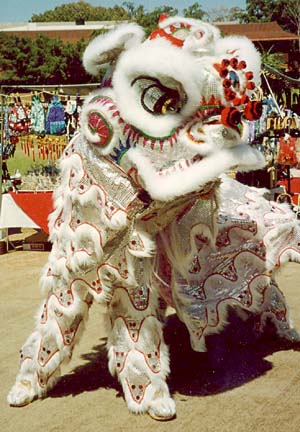
COURTESY OF AIWANA ARTISTS AND EDUCATION COORDINATION
The Senegalese lion dancer prepares for hours, creating the image of a lion using makeup, body paint, costumes and amulets.
Artist discovers
lion dance cuts across
many culturesWhether in Okinawa, Japan,
China or Senegal, one similarity
among the dances is the use of drums
More than a dozen multicolored lions take to the stage in Brigham Young University's "Lions and Drums from Africa." Among the featured performers are eight colorful Chinese lions, a family of hairy Okinawan lions and the Senegalese lion from West Africa.
The single theme of the "lion dance" was selected to highlight cultural diversity and "to draw attention to the way that people and cultures developed in relation to another," said Sonia Chiyomi Fabrigas, of Aiwana Artists and Education Coordination.
Fabrigas began her lion project when she was introduced to the Okinawan lion.
"I didn't realize there were so many different varieties," she said. "Some lions are used for harvest, while others are used for theater. The Africans used the lion dance to keep evil spirits away or identify with their power."
Her aim was to create an awareness that the lion dance existed in many cultures.
COURTESY OF AIWANA ARTISTS AND EDUCATION COORDINATION
Okinawan, Japanese and Chinese lions entertain at a multicultural production at Brigham Young University, above.
"Each lion is unique, with its own look, personality, music and movements, and each captures the qualities that humankind has found interesting enough to imitate."
The white-haired Japanese "shishi," often used in Japanese noh or kabuki theater, dances to the beat of taiko drums. The Okinawan lion is the live, animated version of the "shisa" statues placed in front of buildings and homes to ward off evil spirits and bring good fortune.
The traditional Chinese lion is often "fed" a dollar or two by observers who hope to exchange their cash for a blessing of good fortune. The "Senegalese" lion dancer prepares for hours, creating the image of a lion using makeup, body paint, costumes and amulets.
One similarity among the lion dances is the use of drums. The beats are different, but the drums play an integral part in the dance, explained Fabrigas. American Indians consider drums to be "the sacred heartbeat of everything."
William Hu, in his book, "Chinese Lion Dance Explained," said that the lion's geographic range covered the whole of Africa and South Asia, including Syria, Arabia, Asia Minor, Persia, the greater part of Northern Central India and Central Asia.
"The lion was once venerated in the Middle East as a sacred animal and by the first century was known as 'king of beasts,'" he writes.
Fabrigas added: "The lion was not native to China, so how it got there is still being investigated.
COURTESY OF AIWANA ARTISTS AND EDUCATION COORDINATION
The traditional Chinese lion is often "fed" a dollar by observers who hope to exchange their cash for a blessing of good fortune.
"The awareness of our interconnections is one way we can begin to appreciate the richness of our present moment in history and to respect our differences."
Fabrigas plans to continue to developing multicultural experiences in hopes of promoting peace, tolerance, appreciation and respect.
"I'm always looking for connections," she added. "We are so busy looking at how we are different and unique."
Aiwana Artists and Education is looking for Balinese and Korean lion dancers, and lions are being sought for future performances. Call Sonia Chiyomi Fabrigas at 524-8416.BACK TO TOP |
Lions dancing
"Lions and Drums from Asia and Africa"
On stage: 7:30 p.m. Thursday
Place: Brigham Young University Cannon Activities Center
Admission: $8, $7 seniors and military, $2 children, 50 cents for BYUH students. One child admitted free with two paying adults.
Call: 293-3577 or visit www.byuh.edu
Click for online
calendars and events.



